I’m delighted to welcome guest blogger Dave Sutherland, who provides this peek at our local forest recovering from a recent fire. Dave is a naturalist interpreter with the City of Boulder Open Space and Mountain Parks, where the fire burned just outside city limits. Dave is also our go-to guy on native plants, leading the volunteer team of native plant gardeners at the Chautauqua Ranger Cottage. Here is Dave’s photo essay on the fire zone. Thank you, Dave!
Seven Weeks after the Flagstaff Fire
On June 26 the Flagstaff Fire burned 300 acres on Bear Peak, South Boulder Peak, and the top of Shadow Canyon. Seven weeks later, I got a special permit through my work at Boulder’s Open Space program to enter the fire zone, and I took my camera along. Here is what I found.
On my hike in, I passed through the forest adjacent to the burn. There were flowers, golden grasses of late summer, green trees. Compare this view to next photo, inside the burned forest.
In some places, the fire burned so hot that it reduced the landscape to bare rocky soil, leaving a scene that looked almost lunar—except for the charred remains of tree trunks.
But this next photo was taken adjacent to the previous one. These are tiny aspen shoots sprouting up to reclaim the forest after just seven weeks. As I’ve learned more about how ecosystems work, I’ve come to see that each natural disaster produces some winners and some losers. The aspens are going to be winners. Their deep roots were unharmed by the flames and heat, and true to their pioneer nature, they are wasting no time taking over. In the not-so-distant future, this lunar scape will have become a lush grove of aspens with fluttering leaves.
Brown pine needles had fallen from dead trees, covering the blackened ground with a golden blanket. Everywhere I looked through the scorched remains of the forest, I found signs of life returning.
Just seven weeks after the inferno, fireweed was able to resprout and bloom amid blackened rocks and tree trunks that were sprayed with retardant slurry. Many rocks and trees still bore the red splotches of retardant, dropped relentlessly by the slurry bombers.
Spreading dogbane had returned, and had even managed to produce flowers in many heavily burned areas. Butterflies were busy gathering nectar. In the stillness of the blackened trees, insects chirped, squirrels scolded me, grasshoppers made sudden whirring flights when they were startled. Occasionally I heard the skittering sound of a pine cone falling from some high branch.
And the birds were plentiful and active! Woodpeckers were everywhere, chipping the charred scales of bark off the trees as they searched for insects. They left little reddish patches of unburned bark exposed on the tree trunks. Nuthatches, robins, noisy Steller’s jays, and a pair of ravens explored the forest looking for opportunity. A Cooper’s hawk flew over, screaming.
Signs of the fire’s destructive power were awesome to see.
Where the flames were hottest, entire stumps vanished, leaving only holes in the soil to show where their roots had once been.
The fire didn’t burn with equal ferocity across the landscape. Some places were spared altogether. Others got singed or just got hot enough to injure but not kill the trees. Some places got totally nuked, like this charred stick forest at the top of Shadow Canyon.
Like other wildfires, this one left a patchwork mosaic of postfire conditions—a mosaic of possibilities and opportunities for species to return. Before the fire, the forest had become fairly uniform.
Now, nature has reshuffled the cards, and some species—like the aspens, which had been suppressed under the pines—will burst forth for their turn in the sun. By creating a patchy mosaic of conditions, natural “disasters” like this fire (or hurricanes, earthquakes, avalanches, rock slides, or even asteroid strikes) are actually engines that drive biodiversity.
Where the fire burned away all the surface vegetation, the soil is beginning to erode. Gullies cut through the the ash and gravel. The hiking trails have been heavily damaged by erosion. The upper Shadow Canyon trail, shown above, will require significant work before it can be reopened.
This is the saddle where Shadow Canyon trail joins the two trails to Bear Peak and South Boulder Peak. Somehow the directional signs survived. But the area is still so fragile it will be a while before it can sustain visitor traffic again. We’ll have to fell some of the dead trees that grew next to the trail, since they could become falling hazards. The trails will need extensive work. And the area is networked with fire line cut by the the crews who helped suppress the blaze. The fire lines look like trails, but hiking on them can cause severe damage to the land.
Douglas fir cones that survived the blaze, with their precious cargo of seeds intact, will help restore the forest.
Snowberry shoots poke up from a crack next to a charred tree trunk.
I was amazed by the contrast—appalling destruction alongside rebirth and rejuvenation after just seven weeks.
The burned trees will gradually fall and rot, chewed by insects, hollowed out by woodpeckers, each snag becoming home for many animals. In death, the trees will support an abundance of life.
The forest will return—changed, with a different mix of trees. Winners, losers in an endless cycle of change.

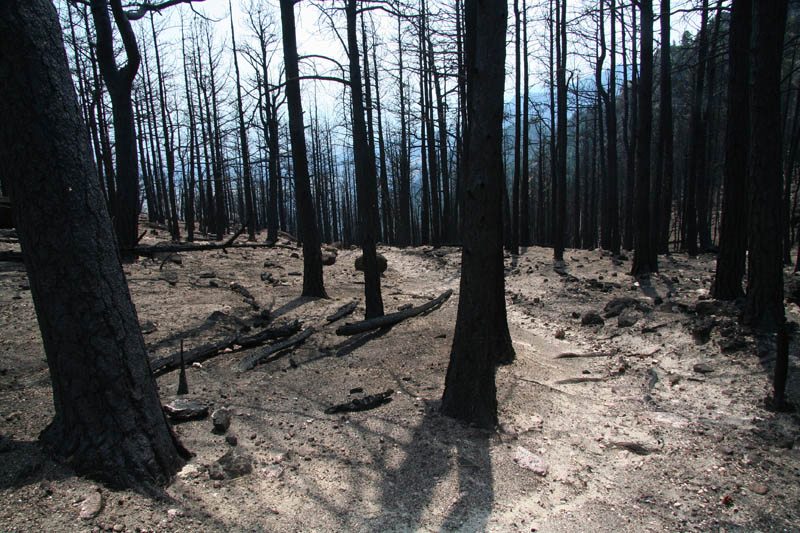
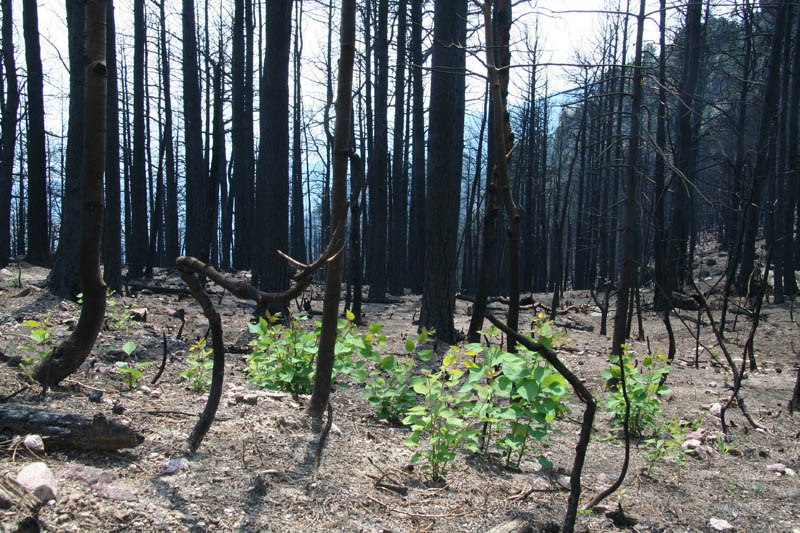
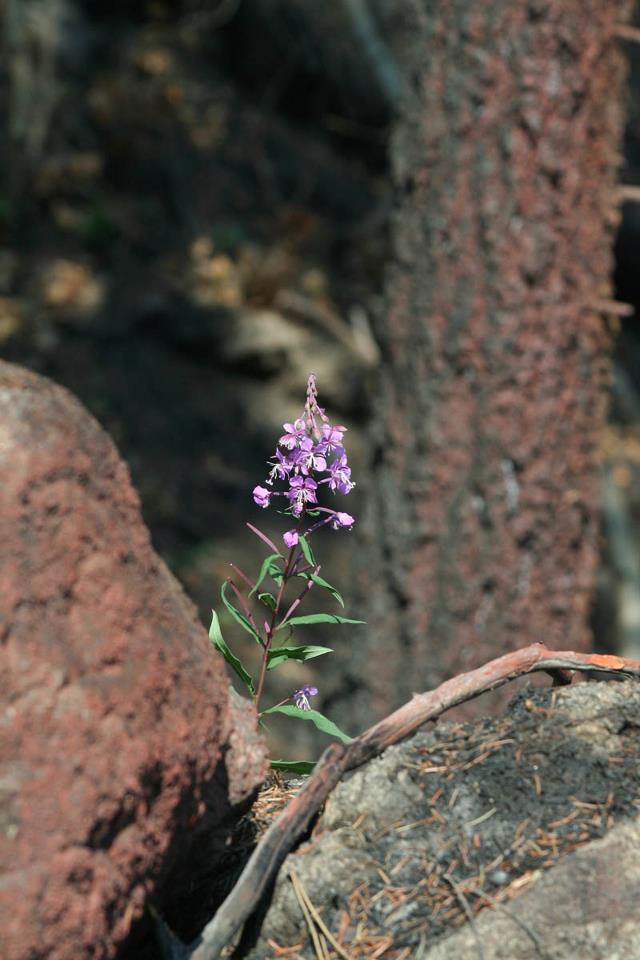
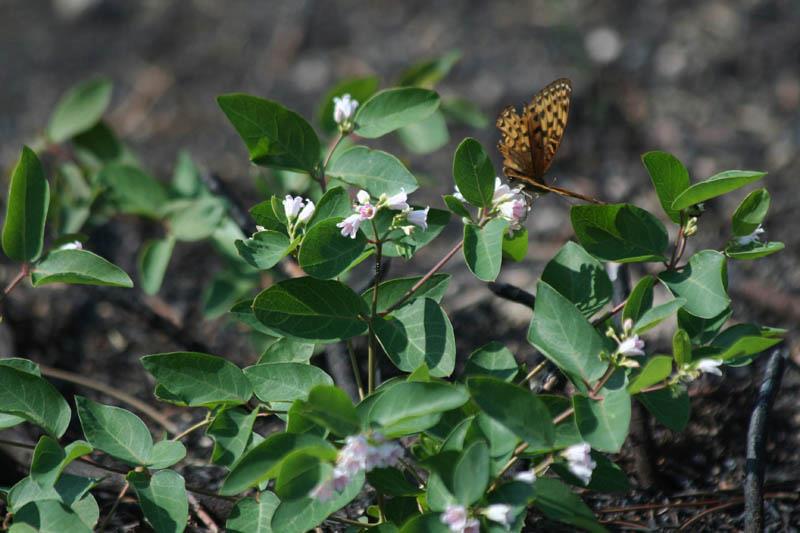
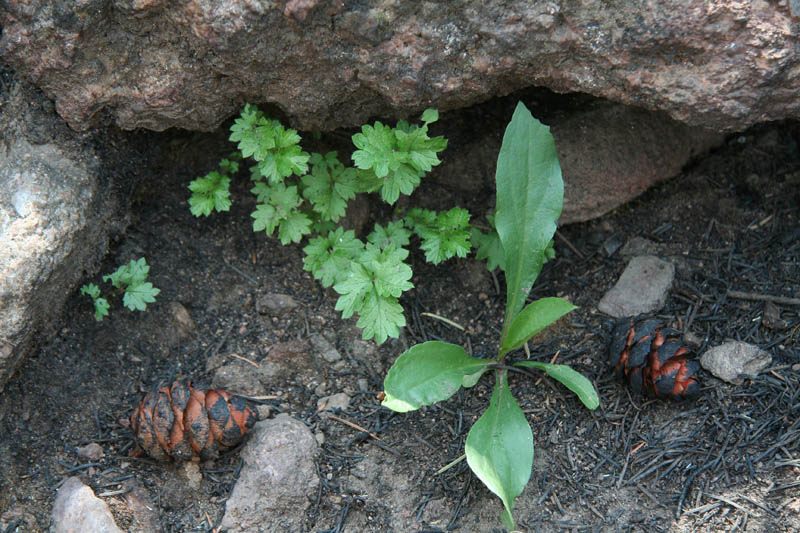

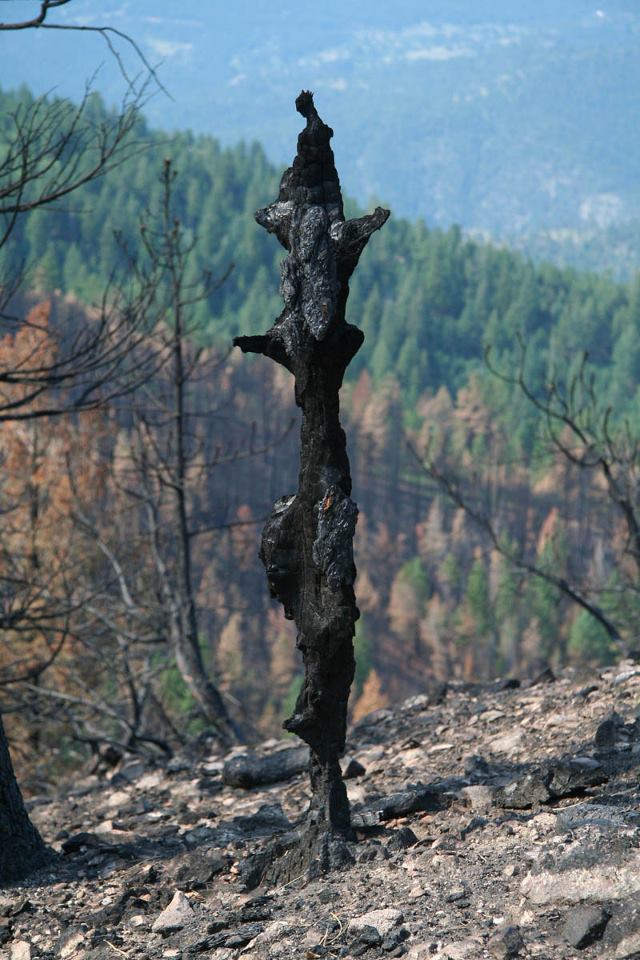
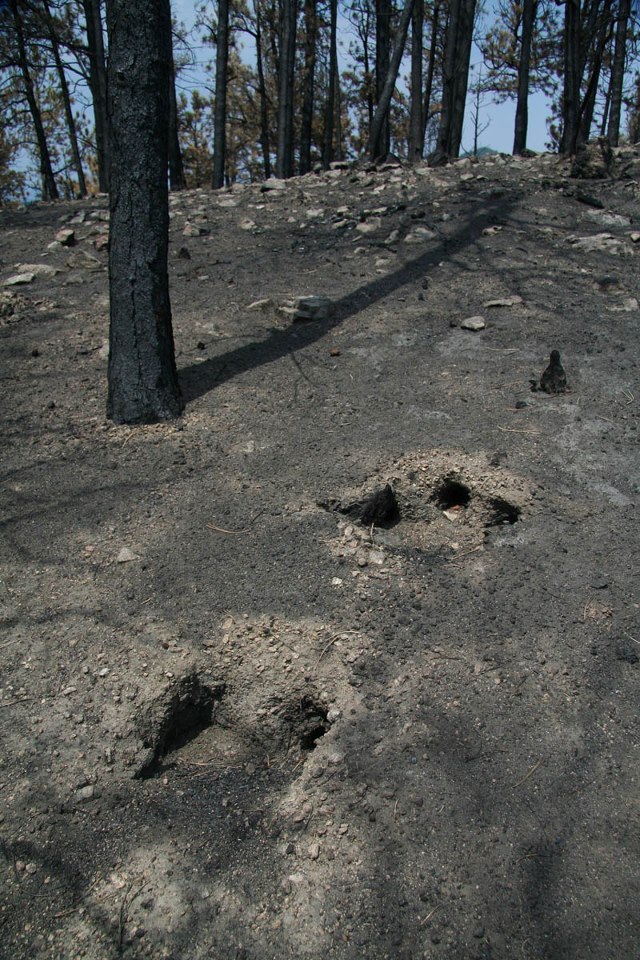
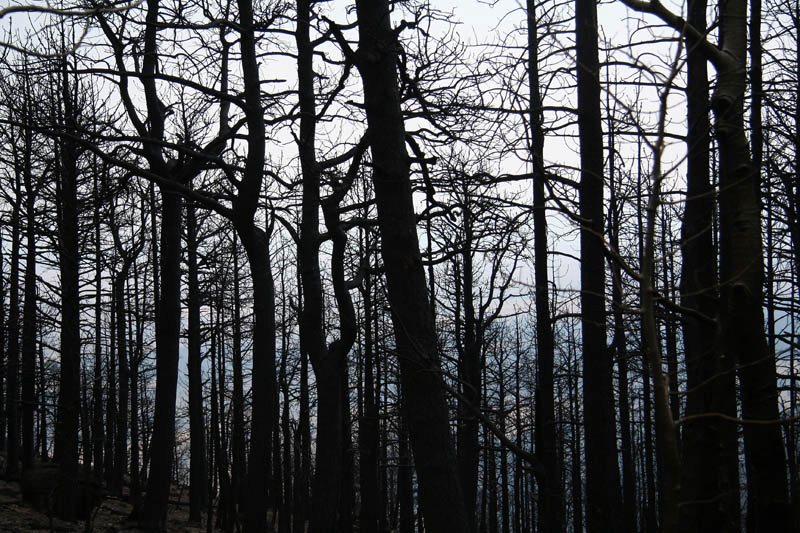
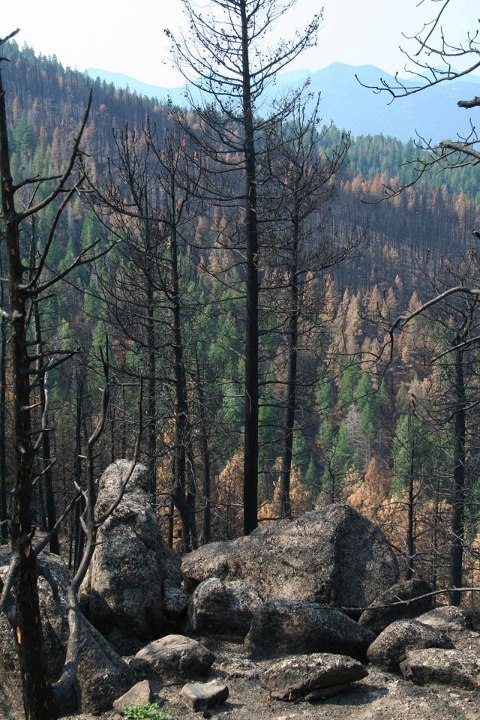

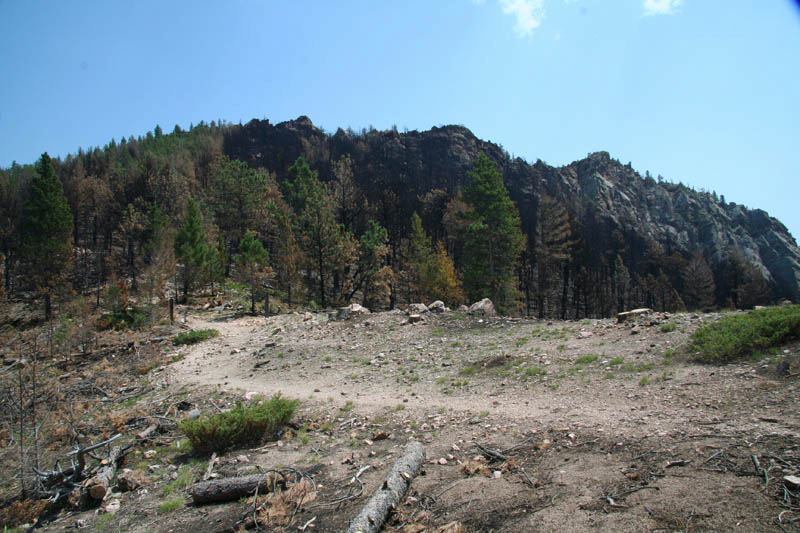
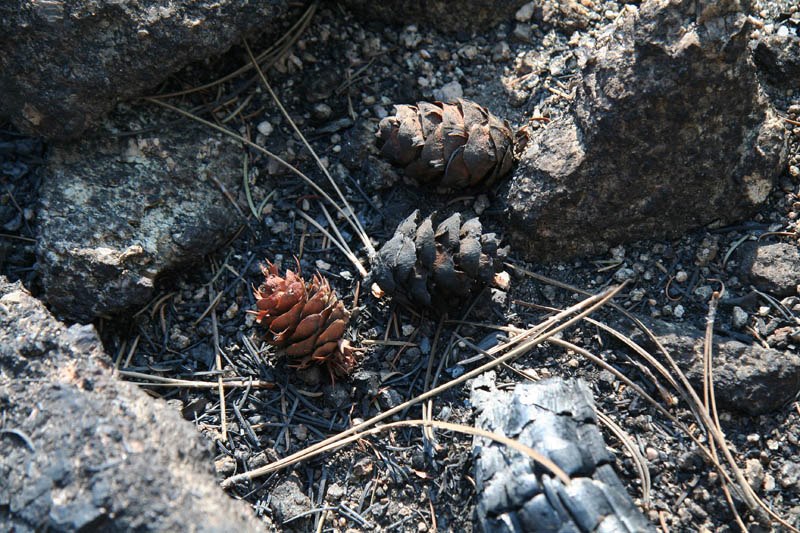
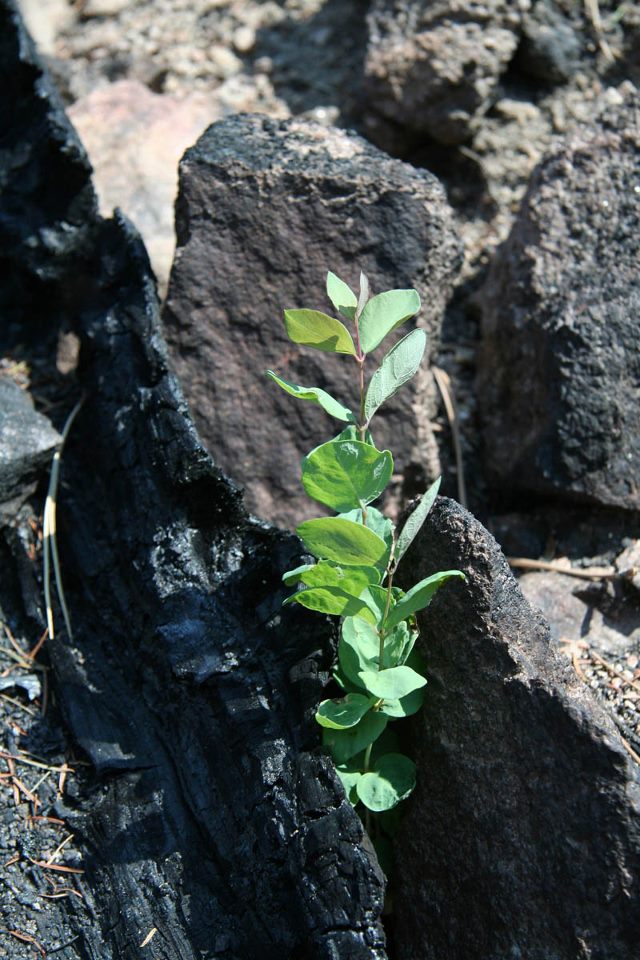
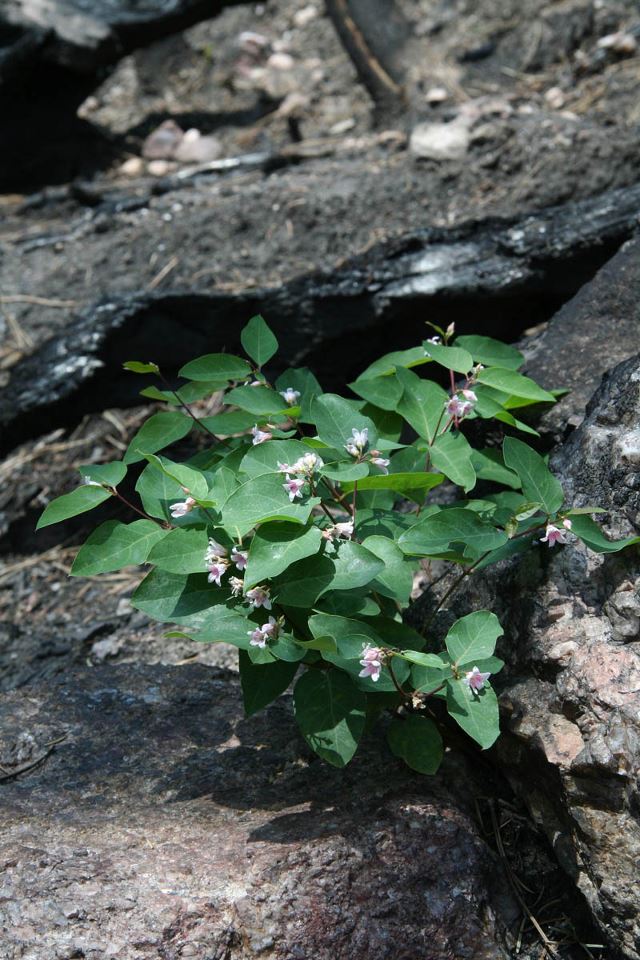
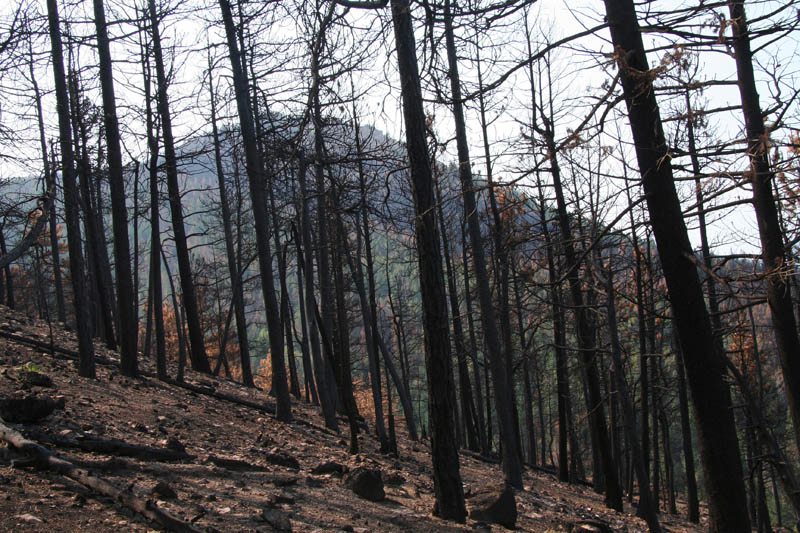

Wonderful post. In these times of mass destruction worldwide it’s encouraging to see how Mother Nature wastes no time restoring ravaged environments.
Priscilla and Dave,
The photographs are beautiful and the story is poetic, and …. I just spent yet another evening pulling invasive weeds from my own fire-scarred land, which in spite of my best efforts, has not recovered gracefully from the Four Mile Canyon Fire. I have acres of sticker-filled, nasty stuff that was once a beautiful native grass meadow. The spring after the fire I re-seeded the entire area by hand, which took weeks. Some of the grass has come in; most has not. Frankly, it’s a mess – not at all lovely or inspiring. It will take years to restore.
Articles like this are uplifting to the general public and to folks who teach fire ecology (which I did for years as a National Park Service Ranger) but the reality of fire recovery is much more complex. I think it’s important to point out how nature renews itself in such lovely ways, and also the fact that sometimes fire leaves the land not so lovely, and it takes much care and effort to restore.
Just another perspective to add to the mix,
Andi
Andi: We’ll just have to wait and see how the land recovers. I expect we’ll see a lot of weeds returning – mullein, cheat grass, etc. But the area on the back side of Bear Peak / South Boulder Peak was a pretty undisturbed plant community with a lot of natives. I’m optimistic that we will get a lot of natives returning to the mix. Fortunately, we had long-term veg monitoring plots up there, so we’ll be able to quantify the recovery.
I am personally concerned about the erosion, which is very significant in some places. I hope it will be graceful – as a true post-fire mosaic, I’m sure it will be ins some places, but less so in others.
This is humbling, and deeply moving to me. Beautiful, sad, glorious. Thank you, Dave, and Priscilla for having him as your guest. The teaching is about not separating disturbances from the rest of life (in our minds), and understanding that it is all one whole, one earth, one life. Looking straight into it this way with these intriguing photographs makes one want to know more and to be closer to it all rather than run or avoid the “disaster.” I love that our city and county pay attention and try to do the right thing when it comes to the human relationship with the rest of nature. We do the best we can though a lot of it is out of our hands.
Andi, I’ve been watching the burn area on Bald Mountain closely, and I notice that areas where soil was disturbed after the fire have a lot more of the not-so-lovely invasives. The invasives have completely taken over some areas close to the trail, where loggers came in to cut burned trees. Areas closer to human dwellings have more invasives than those farther away. The land seems to remember its history; where there was soil disturbance, even in the more-distant past, invasives had gotten their hold and were lying in wait, ready to get spurred into action by the land-clearing action of a fire.
The issue of invasives is a complex one, as you know, because it involves human impacts (not just fire impacts). Mining and construction have left their traces on the land. Even the well-intentioned act of logging burned trees to protect hikers from falling trunks and to provide soil stabilization can have not-so-pretty consequences because all that trampling around and dragging of logs on freshly burned soil is itself a huge disturbance and will spur the more opportunistic plants into action.
Here’s hoping that as you care for your land by encouraging grasses and native plants, the soil will cover over again, leaving less work to be done by the less-lovely varieties.